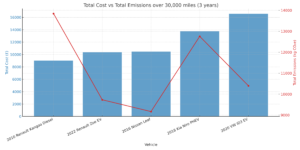Become part of the practical transport philosophy
‘Bangernomics’ – the art of running inexpensive older cars, is for some a lifestyle decision that balances cost, practicality and even nostalgia. For others, it’s simply the most viable financial option. The term, coined in the early 1990s by motoring journalist James Ruppert, reflects a growing counterculture within the automotive world.
A key criticism of Bangernomics is the carbon cost of running older petrol or diesel cars. While EVs are designed with emissions standards and tech that reduce pollution, older vehicles may have failing or outdated systems. Pre-2001 cars, in particular, can struggle to meet Clean Air Zone (CAZ) requirements – and may be penalised accordingly.
So, what are the options if you want to buy an older second-hand car and be part of a practical transport philosophy?
Thinking of buying a bangernomic EV?
The numbers are compelling. Even when factoring in manufacturing emissions, EVs come out ahead in lifetime carbon footprint. While it’s true that EV production – especially batteries – has a high initial carbon cost, this is quickly offset once the car hits the road. One study shows a 2025-registered electric vehicle generates 32% fewer CO₂ emissions over its lifetime, compared to a modern diesel equivalent.
Consider running costs, too:
- 100% EVs cost about 9p per mile
- Average petrol cars cost around 19p per mile
And, if you’re charging an EV from solar or off-peak tariffs, the benefits multiply. For the right driver and location, EVs offer a compelling financial and environmental case.
Why bangernomics is winning
Lower purchase cost
The main attraction of bangernomics is clear: low upfront costs. While new and nearly-new cars come with hefty price tags, older vehicles are often sold for a fraction of that – allowing owners to pay cash, avoid finance, or even afford a second car.
What matters most isn’t necessarily age, but condition. A 10-year-old car with a full service history may outperform a five-year-old vehicle that’s been poorly maintained. Plus, the freedom from worrying about minor dents and dings makes the driving experience refreshingly stress-free.
Reduced depreciation
Older cars depreciate at a slower rate = less financial loss if you decide to sell it later. In the UK, most second-hand cars purchased are typically between 3 and 8 years old. However, a significant portion of the used car market consists of vehicles over 10 years old (the ‘Bangers’). Nearly a third of cars are over 12 years old (the average age of a car in the UK is around 9.4 years).
- 3-8 years old: this range is often considered the ‘sweet spot’* as cars in this age group have typically depreciated in value, but are still relatively new and less likely to have major mechanical issues.
- Over 10 years old: while these cars may be more affordable, they may also require more maintenance and repairs.
*I have found a sweet spot for a small van/car: Renault Zoe Van 2022 - 245 miles range and an average of £6k to buy. This works out at £0.30 per mile (£0.18/km) total cost of ownership. In theory, at about 35,000 miles (2-5 years for the average driver), the EV will have already reached ‘break even’ (embodied carbon) and three years of totally carbon neutral travel - if charged off PV generated power.
Break even in this case means that the EV has saved enough emissions from not burning fossil fuels (compared to an equivalent petrol/diesel car) to offset the higher emissions from producing it - especially the battery.
The reasons why some drivers won’t buy a bargain banger
Unreliability
Older cars are, inevitably, more prone to breakdowns. Government and breakdown service data show a direct correlation between vehicle age and reliability. According to National Highways, breakdowns on motorways and A-roads have risen 20% in the past five years – a sign of an ageing national fleet. And, yes, potholes deserve a mention here, too.
For drivers reliant on their vehicle for work or family duties, breakdown risk may outweigh the cost benefits. Bangers might be perfect for weekend DIY runs – but less ideal for 200-mile round trips (unless they are very well maintained).
Safety Concerns
Many older cars lack the safety features that are now standard: airbags, anti-lock brakes, crumple zones, and electronic stability control. These gaps may not matter on short, low-speed commutes – but for regular, high-speed journeys, the lack of modern protection is a concern.
Repairs can also be unpredictable. DIY enthusiasts might welcome the challenge, but the need for specialist parts or labour could erode any initial savings.
So… what happened when we bought a ‘banger'?
I have always thought of cars in terms of cost per mile (no matter what the means of propulsion). For instance, PRL bought a cheap ‘builders van’ which is now at the last stages of its usable life. Over 2 years it has cost us approximately £0.36 per mile - however, we have had to factor in the cost of repairs.
In terms of Carbon (Well-to-Wheel (WtW)/Cradle-to-Grave (CtG), the embodied carbon for 16 years is:
Manufacture = 6 tonnes
Used = (190,000 * 1.61 = 305,900)
Total = (305,900 * 154 = 47.1 t)
Circa 74 tonnes = 240g per km
After 25000 miles in a classic ‘bangernomics’ builders’ van the experience was actually fun: it was extremely practical, tough as old boots and essential for working on house builds and retrofits.
The PRL Second-Hand Vehicle Comparison
We wanted to take a deep-dive into what it takes to run a variety of different 'bangers'., and compared them using total cost of ownership (TCO) and carbon emissions. The focus was on five second-hand vehicles, over a three-year usage period and a total of 30,000 miles. The analysis includes: Electric Vehicles (EVs), a plug-in hybrid (PHEV), and a diesel van.
Vehicles Compared:
- 2010 Renault Kangoo 1.5L Diesel Van
- 2022 Renault Zoe EV Van (52 kWh battery)
- 2020 VW ID3 EV (60 kWh battery)
- 2016 Nissan Leaf (40 kWh battery)
- 2018 Kia Niro PHEV

The chart above shows a clear distinction between the financial and carbon performance of EVs, compared to the internal combustion engine (ICE) and plug-in hybrid vehicle. Full electric vehicles consistently offer lower use-phase emissions and, over time, become more cost-effective, despite slightly higher purchase prices.
Conclusions:
1. The 2016 Nissan Leaf offers the lowest total carbon emissions over 30,000 miles.
2. The 2022 Renault Zoe is the best balance of low cost and emissions, particularly for commercial or utility use.
3. The diesel Kangoo, while cheapest upfront, results in the highest lifetime emissions.
4. Plug-in hybrids like the Kia Niro occupy a middle ground, but do not outperform full EVs in either category.
5. The total cost of ownership for EVs is now competitive with older ICE vehicles, particularly as fuel prices remain high and EV maintenance is minimal.
Our bangernomics recommendations
If you’re practising Bangernomics but want to reduce your carbon impact too, now is an ideal time to invest in a second-hand BEV or longer-range PHEV (Plug in Electric Vehicle).
Prices are lower, batteries are reliable, and infrastructure is improving. Models like the Nissan Leaf and Renault Zoe strike an ideal balance between cost and sustainability.
For around £7,000, you can run an EV for under £0.30 per mile over 30,000 miles – which is significantly cheaper than petrol or diesel alternatives.
The greenest Bangernomics is a used BEV (Battery Electric Vehicle) or REx (Range Extender).
And, the only thing cheaper? An electric folding bike.
Is the ultimate low carbon solution to ditch the car completely?
Yes, real low carbon travel is not using a car at all. And, if you live in a location that’s within 15-20 minutes away from all the amenities you need, then this becomes a realistic proposition. It might though be more practical to repair vehicles and create a market for retrofitting EV crate style kits. VW has trialled this for classic VW Type 2 camper vans and Beetles, allowing for easy conversion to electric power. These kits, often featuring pre-packaged battery packs, motors, chargers, and other necessary components, aim to simplify the conversion process. I can honestly say that for me, after nearly 50000 miles of EV driving in an ID3, this was a really good solution. However, these cars can be expensive to lease.
My maxim: "You can only talk about it when you’ve done it!" This is why we always walk the walk at PRL.
Carl Dodd, Property Revolutions Ltd.


